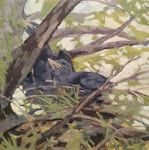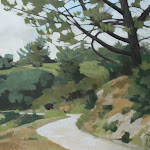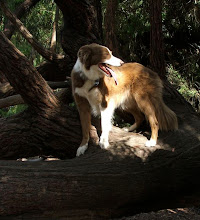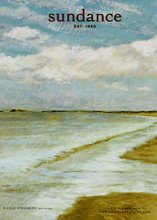Tuesday, October 30, 2007
Maira Kalman: The illustrated woman
Available on youtube, an inspiring lecture by the illustrator Maira Kalman.
Monday, October 29, 2007
Saturday, October 27, 2007
Fall Color

Beautiful fall colors from the blooming persimmon tree.
Inspiration:
Mien's studio BLOG
Sara Mitchells BLOG
and photos of her fabulous books
Wednesday, October 10, 2007
technicolor undergrowth

I'm still working with the images of the jasmine vines, making many varied color studies, embossings and solar plate variations. The more test plates that are made, the more convinced I am to make a patch work quilt style print with all the myriad of plates on one sheet of paper.
These two images were printed with four plates, inked in four colors, placed side by side on the press and run through twice. It sounds more complicated than it is, printmaking is an interesting medium with endless variations on a theme. It is always my goal in printing to explore colors and textures while mining one subject for all it's worth.
How it translates into my painting you ask? Firstly, the instant gratification of making a brush mark on the panel is ever so much more satisfying after a frustrating day at the press. You see, the printing process can deliver many, many duds before the treasure is discovered in the just right combination.
Secondly, being able to focus on color once the plate is made is astounding. Having the subject and composition resolved allows pure focus on the use of color. With paintings, there is always the adjustments to color and composition throughout the process. There is some of that in printing, but most of the plate adjustments occur early in the process and then it's just printing for printing sake.
At the end of the day, you are looking at a stack of prints, same image, different techniques of applying ink and innumerable color variations. Fantastic!
Look for these soon on my SHOP at Etsy.
Sunday, October 7, 2007
Not to be Missed - Huntington Library

“Pressed in Time: American Prints 1905–1950”
The MaryLou and George Boone Gallery
at the Huntington Library, San Marina, CA
Oct. 6, 2007 - Jan. 7, 2008
The first half of the 20th century was a particularly fertile moment in the history of American printmaking. Throughout this tumultuous period, which saw two world wars and the Great Depression, printmaking served as a cost-effective form of artistic expression and means of communicating artists’ observations and ideas. A new group of urban realists, some of whom were members of the so-called Ashcan School, began to depict scenes from everyday public life in prints as well as paintings. At the same time, some print-makers started to explore modernist aesthetics. Outside of urban centers, artists focused on rural communities and landscapes as the source of subjects. America offered limitless opportunities for the imaginations of printmakers and they, in turn, captured this exciting phase of United States history with dynamic, innovative work.
“Pressed in Time: American Prints 1905–1950” presents rarely-seen material from The Huntington and from two important private collections. Hannah S. Kully, who has promised her collection of American prints to The Huntington, lent nearly three-quarters of the pieces included in the exhibition. All of the examples of John Sloan’s work on view were lent by Gary, Brenda, and Harrison Ruttenberg, who have promised and begun donating their extensive John Sloan collection to The Huntington. The 163 prints selected from these three collections for this installation, represent the work of 82 artists who expressed distinctive aspects of the American experience. As Benton Spruance declared in 1937, he and fellow American printmakers sought “the symbols that mean ourselves, the way we think, the plans and hopes of our lives,” regardless of their choice of style or subject.
The exhibition begins with prints that show various aspects of cities such as Chicago, Philadelphia and, particularly, New York. Artists attracted to modernist styles influenced by Cubism tended to portray the architecture of the city rather than its inhabitants, as in Samuel Margolies, Man’s Canyons. Other printmakers, such as John Sloan, were attracted to the people of the city as their primary subjects. Sloan began his career as a newspaper illustrator in Philadelphia and later drew on his talent for capturing fleeting incidents of urban life to create lively images, peppered with social commentary. His print Barber Shop shows two barbers and a manicurist at work on customers, while a waiting patron reads the satirical weekly Puck, with the socialist magazine The Masses at his side. Also in this section, works such as Miguel Covarrubias’s The Lindy Hop reflect printmakers’ attraction to new urban modes of entertainment: nightclubs, amusement parks, movies, and prizefights.
Both urban and rural communities were affected by the Great Depression, the economic downturn that began in 1929 and lasted throughout the 1930s, and was exacerbated by a drought that devastated much of the agriculture and society in the Great Plains. Artists such as Robert Gwathmey captured the endemic transience of the time in prints such as The Hitchhiker from around 1937. Despite these hardships, farming and other aspects of rural life continued to captivate artists who employed a variety of styles and print techniques. Bernard Steffen’s screenprint Haying uses color and composition to evoke the kinetic motion of farmers pitching hay.

While dealing with diverse themes, the exhibition focuses on prints in which the medium and message come together to made a strong, unified statement. In the case of Paul Landace’s Death of a Forest, the stark contrasts of his wood engraving dramatically suggest the white-hot flames and dense clouds of smoke of a forest fire in the mountains near Los Angeles. Just as Landacre creatively depicted a topical subject, one that is still quite common, all of the artists represented in this exhibition created powerful, iconic works of art that captured various aspects of the innovative, turbulent, and vital culture of their day. Additional information and illustrations can be found in the book Pressed in Time: American Prints 1905–1950, available in The Bookstore & More.
This exhibition is co-curated by Jessica Todd Smith, Virginia Steele Scott Curator of American Art, and Kevin M. Murphy, Bradford and Christine Mishler Assistant Curator of American Art. An illustrated catalog and audio guide have been produced to accompany the show.
Subscribe to:
Posts (Atom)









